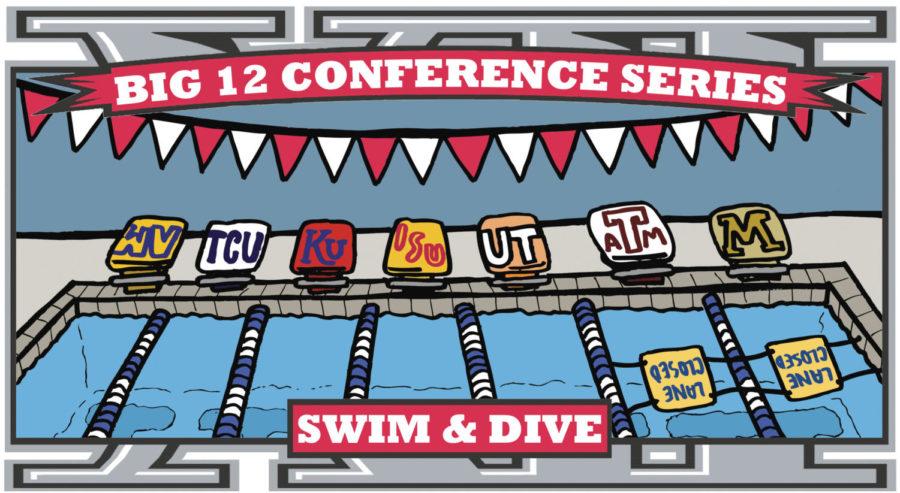Big 12 Series: Swimming and diving remain afloat with conference realignment
Illustration: Ryan Francois/Iowa State Daily
Swimming and diving stays afloat with changes to the Big 12 conference.
April 12, 2012
With the departure of Texas A&M and Missouri and the subsequent arrivals of both Texas Christian University and West Virginia in the Big 12 Conference, it will undergo major changes this upcoming athletic season.
For swimming and diving, the changes will have an adequate effect on the Big 12. Last season, for instance, there were seven teams in the conference, but the departure of Colorado and Nebraska shriveled it to five.
After this season, the conference will still retain five teams since all four teams in transit — TCU and West Virginia coming, Texas A&M and Missouri going — have swimming and diving teams.
“We are sad to see such quality programs with A&M and Missouri leaving,” said ISU swimming coach Duane Sorenson. “We’ve had great history through the years with Missouri, and I think it’s been 18 or 19 years in a row we’re against them, and it’s always been great meets.”
Missouri and Texas A&M are both considered traditional powerhouses in the conference since both rank in the top 20 in the conference and regularly challenge Texas for the conference championship each year.
“We think TCU and West Virginia are both great additions to the Big 12 in any sport they’re in,” said Bob Burda, Big 12 associate commissioner of communications. “I don’t want to necessarily conceive that Texas A&M and Missouri were the power residing in the Big 12 for swimming, but they certainly have competitive programs.”
Since the creation of the Big 12, Texas has won a monstrous 10 of the 15 conference titles. A&M has claimed four while one was claimed by departed Nebraska.
The balance of power will shift much more favorably toward Texas, which finished the season ranked No. 3 in the country.
TCU, which finished fifth in its final season in the Mountain West Conference, has not generally been considered a powerhouse program but has been known to produce excellent swimmers.
“We’re excited as a university, and our program’s very excited [to join the Big 12],” said TCU women’s coach Richard Sybesma. “The bar’s been raised with the University of Texas, obviously, and all the other schools are very good swimming schools.
Last season, the Horned Frogs finished the season with a 4-4 women’s record and 4-1 for men’s record in the conference, but had five swimmers named to the all-conference team.
“So we’re going to be swimming against the best and diving against the best in the country,” Sybesma said. “It’s just going to be great to have a conference meet with the best teams in the country.”
West Virginia, on the other hand, finished third for women and second for men in the Big East Conference last season. Although they were not nationally ranked, the men’s team received votes in the national poll.
“I think the Big East has been very good to West Virginia,” said WVU women’s swimming coach Victor Riggs. “But to be honest, our sport leaving was probably not a big part of the decision, as many Division I programs are focused on basketball and football.”
At the Big East Championships, West Virginia fell to third, but Riggs was awarded the Big East Women’s Coach of the Year.
“There’s mixed feeling,” Riggs said. “There’s certainly going to different challenges as we enter into the Big 12, but we enjoyed our time in the Big East, and it’s a very competitive conference.”
In the midst of all of the departures and arrivals, Iowa State will have to compete against the new competition.
Iowa State has traditionally struggled in conference play, having never finished higher than fourth in the Big 12 tournament.
“Both [West Virginia and TCU] are going to be competitive with Kansas and our program,” Sorenson said. “So it should be a much more balanced Big 12 meet compared to the past.”
As far as travel is concerned, the Cyclones will not have to wander too far as they will remain in the Midwest for the season and will not travel to the East Coast to compete against West Virginia.
“In swimming, we compete in more regional rather than dual meets,” Sorenson said. “So we don’t have a dual meet schedule set up by the Big 12, so we swim when we can.”
Iowa State has never faced TCU or West Virginia in competition before, but Sorenson is quite familiar with TCU.
“I know the Texas Christian coach very well,” Sorenson said. “When I was coaching club swimming one of my swimmers swam for him back in the ’80s. Richard’s been there for eons and eons.”
Last season, the Cyclones finished last at the Big 12 Championships scoring a total of only 328 points, 104 points behind the next closest team.
“Texas and Texas A&M have had quite a rivalry the last few years,” Sorenson said. “[Texas] will be the clear favorite program, and then who wants to take second is what it going to boil down to.”
As far as the competitiveness of the new-look Big 12, Sorenson doesn’t think the added level of competition will be a damper on his team.
“It should be a lot of fun going into the new conference setup,” Sorenson said. “And human nature says when you have a chance to win you will compete that much harder. We could get second [in the conference] or we could get fifth, that’s how close it’s going to be.”







